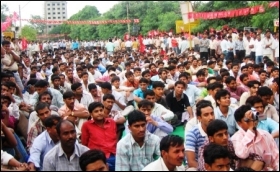|

|
51 pc workforce in country self-employed: Study
|
|

|
|
| Top Stories |
 |
|
|
|
SME Times News Bureau | 21 Jun, 2013
Around 51 percent of Indian workers are self-employed, mostly in rural areas, while 33.5 percent of them are casual labour (33.5 percent) and only 15.6 percent have salaried employment, an official survey revealed Thursday.
"Among workers in rural areas, 54.2 percent are self-employed as against 41.1 percent in urban areas and 38.6 percent work as casual labour as against 17.5 percent in urban areas," India's chief statistician T.C.A. Anant told reporters in Bangalore.
Releasing the latest socio-economic study conducted by the National Sample Survey Office (NSSO) of the ministry of statistics and programme implementation from July 2011 to June 2012, Anant said salaried employees or workers with regular wages were nearly six times more in urban areas (41.4 percent) than 7.3 percent in rural areas, showing the wide disparity in the employment comfort level of the workforce across the country.
"The survey on employment and unemployment is meant to estimate the labour force participation rate, worker population ration and unemployment rate and assess their activity to identify the pattern of household expenditure and consumption," Anant, who is also secretary of the ministry, said on the occasion.
The survey was carried in 7,469 villages and 5,268 urban blocks spanning districts and states across the country, covering about 101,724 households, including 59,700 in rural and 42,024 in urban areas.
"The survey also indicated a three percent employment growth from January 2010 to January 2012, with 13.9 million (1.39 crore) people joining the workforce across the country, resulting in 472.9 million (47.29 crore) people employed in 2011-12 as against 459 million (45.9 crore) in 2009-10," NSSO additional director-general Samiran Malik said.
Of the total (472.9 million) employed in 2011-12, 234.6 million were men and 101.8 million women in rural areas and 109.2 million men and 27.3 million women in urban areas.
In contrast, of the total 459 million in 2009-10, 231.9 million men and 104.5 million women were in rural areas and 99.8 million men and 22.8 million women were in urban areas.
Though the national sample survey (NSS) is conducted every five years (quinquennially) with the previous survey from July 2009 to June 2010, the ministry has decided to do it midway to asses the impact of global recession and financial crisis in 2008-2010 on the Indian economy, employment and incomes.
"The survey has been a regular exercise every five years to collect data for the Planning Commission and other user agencies to formulate plan periods and socio-economic programmes for inclusive growth and improve the quality of life in rural and urban areas," Anant said.
The study also revealed that the average wage or salary in urban areas at Rs.365 per day is higher than in rural areas at Rs.232, with men paid Rs.377 and women Rs.309 in urban areas, while it is Rs. 249 for men and Rs.156 for women in rural areas.
"The latest survey shows that the male-female wage ratio is 0.82 in urban areas and 0.63 in rural areas," Anant pointed out.
Similarly, daily wages for casual labour in urban areas for non-public works is Rs.122 as against Rs.93 in rural areas. The pattern repeats in average wage per day for urban men and women (Rs.132 & Rs.77)and their rural counterparts (Rs.102 & Rs.69).
"About 40 percent of population constitutes labour force, with 41 percent of them in rural areas and 37 percent in urban areas. The labour force participation rate is 56 percent for men and 23 percent for women," NSSO director-general and chief executive Vijay Kumar said.
Of the 1.21-billion people in the country, the worker population ratio is 39 percent at the national level, with 40 percent in rural areas and 36 percent in urban areas.
In the worker population ratio, 54 percent are men and 22 percent women in urban and rural areas.
|
|
|
| |
|
|
|
|
|
|
|
|
|
|
|
|
|
|
| |
| Customs Exchange Rates |
| Currency |
Import |
Export |
US Dollar
|
84.35
|
82.60 |
UK Pound
|
106.35
|
102.90 |
Euro
|
92.50
|
89.35 |
| Japanese
Yen |
55.05 |
53.40 |
| As on 12 Oct, 2024 |
|
|
| Daily Poll |
 |
 |
| Do you think Indian businesses will be negatively affected by Trump's America First Policy? |
|
|
|
|
|
| Commented Stories |
 |
|
|
|
|
|
| |
|